Back to top: Overview of Unit A16
Location
Unit A16 is adjacent to units A11 and A13, with which it shares the stratigraphy. A11 started at a higher, and A13 at a lower, elevation than A16. In turn, excavations in A11 stopped at the Khabur levels, while in A13 they were carried down all the way to the level of the Palace.
A15 was started at the same time as A16, while A17 and A18 were started in 2003.
|
|
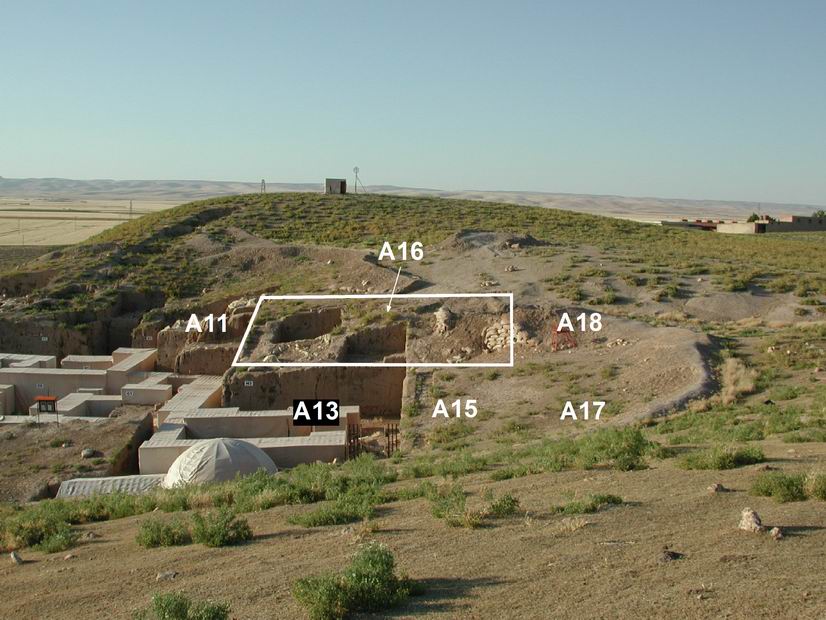 |
Back to top: Overview of Unit A16
The pertinent areas
AA is the main area to which unit A16 belongs. It refers broadly to the area that includes the Palace and the settlement above it.
The lower portion (with the courtyard), belongs to area AP (the Palace proper) and, more specifically, to area AF (the formal wing of the Palace).
The higher strata may be assigned to a distinctive area that will include only the later settlements (or possibly three areas, distinguishing between the broad horizons of the Mittani, the Khabur and the Ur III periods), but no firm decision has been reached as yet.
Back to top: Overview of Unit A16
Physiognomy
The physiognomy of A16 is defined by the unique typology of some of the structural finds, by the modifications that these caused in the overall strategy, and by some of items, in particular the glyptics.
Back to top: Overview of Unit A16
Khabur period grave complex
Another significant change came about as a result of the excavations of A16, namely a new insight into the typology and the urban setting of the graves in the Khabur period. Nowhere else do we have evidence as in A16 for the coalescing of mortuary structures into a coherent urban whole, which appears as a small “city of the dead,” each grave resembling a miniature house with its courtyard.
Back to top: Overview of Unit A16
Impact on strategy
A16 was opened with the specific intent to descend to the level of the stone paved courtyard of the Palace, which had been originally been discovered in A13. The discoveries from the upper levels made in the process caused an important shift in overall strategy.
Until this point in time (2002), substantial structures were found primarily in the northern units (from the west, respectively, A7, A2, A9 and A11), and here we stopped excavations at these levels, without continuing to the level of the Palace. In the southwestern portion, instead, we were in an area which I had defined as “scattered occupation,” by which I meant an open area without any definable structural remains (again from the west: A5, A1, A6, A8, A13, A12, A14).
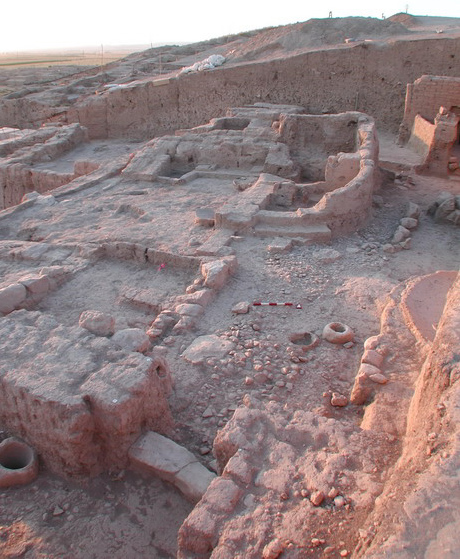
In A15 and A16, on the other hand, we began to find regular structures, as in the northern portion of the area. As a result, these two units were the last ones where excavations progressed vertically to the level of the Palace, and even this not for the entire area of the unit. From this point on, the decision was made to obtain fist an horizontal exposure for each of the later strata before reaching the level of the Palace.
Back to top: Overview of Unit A16
The Palace courtyard
A16 produced the largest exposure of the Palace courtyard to date (a12). Presumably the courtyard extends for the full extent of the unit, but only half of it had been excavated to this level, for the reasons mentioned above. The courtyard has a beautiful stone pavement which gives us a gleam into the monumentality of the formal wing of the building.
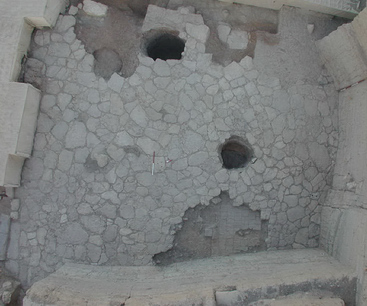
Back to top: Overview of Unit A16
Glyptics
A small group of seal impressions was found in the layers above the stone paved courtyard. Their style is distinctive within the corpus of Urkesh glyptics, and sheds light onto yet another aspect of the Urkesh art scene.
Back to top: Overview of Unit A16
Phases
June 2016 - C. Chaves Yates
Phase 4jAAH The lowest excavated materials in A16 are found in the southwest corner where the paved courtyard has been uncovered. The construction of this pavement and associated features are dated to phase 4j.
Phase 4kAAH During this phase the paved courtyard was in use. As the courtyard was kept clean, there are no features dated to this phase.
Phase 4mAAH Strata immediately overlaying the paved courtyard when the palace was reused as a dependence.
Phase 5cAAH Collapse of palace and the reshaping and reworking of the area.
Phase 5hAAH Scattered occupation including tannurs. Burial pits dug into collapse material and through the pavement.
Phase 6cAAH Dumping and creation of large pits. Some burials and assorted accumulations.
Phase 6hAAH Construction of above ground burials.
Phase 6mAAH House tumuli burials
Phase 6sAAH Brickfall covering whole area.
Phase 9cAAH Brickmelt and old surface of the tell.
Phase 9sAAH Topsoil and mixed accumluations.
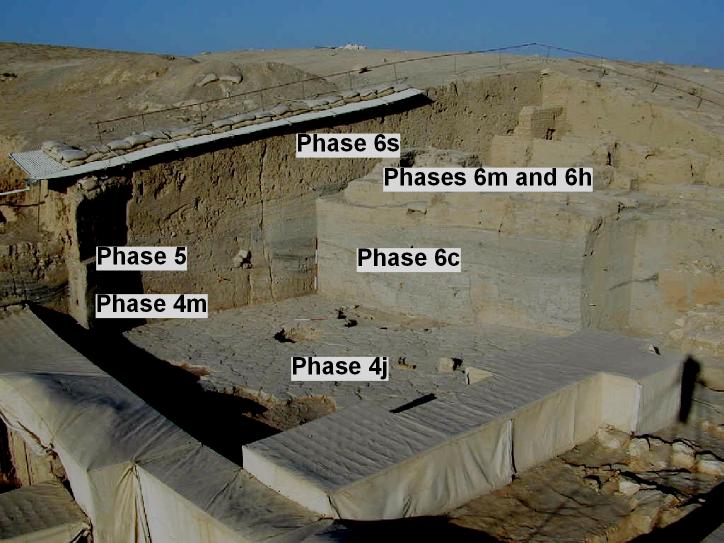
Back to top: Overview of Unit A16
Beginning of excavations
Excavations began on June 6, 2001. The photo shows the situation on that day. The eight loci, defined at the beginning and here shown in white, served as the main squares throughout the remainder of the two seasons.
The three squares k1, k5 and k6 had already been opened as part of unit A13 in 1999. The sand bags to the east of k4 and k8 were placed to block the flow of water from a secondary wadi coming from the northeast.
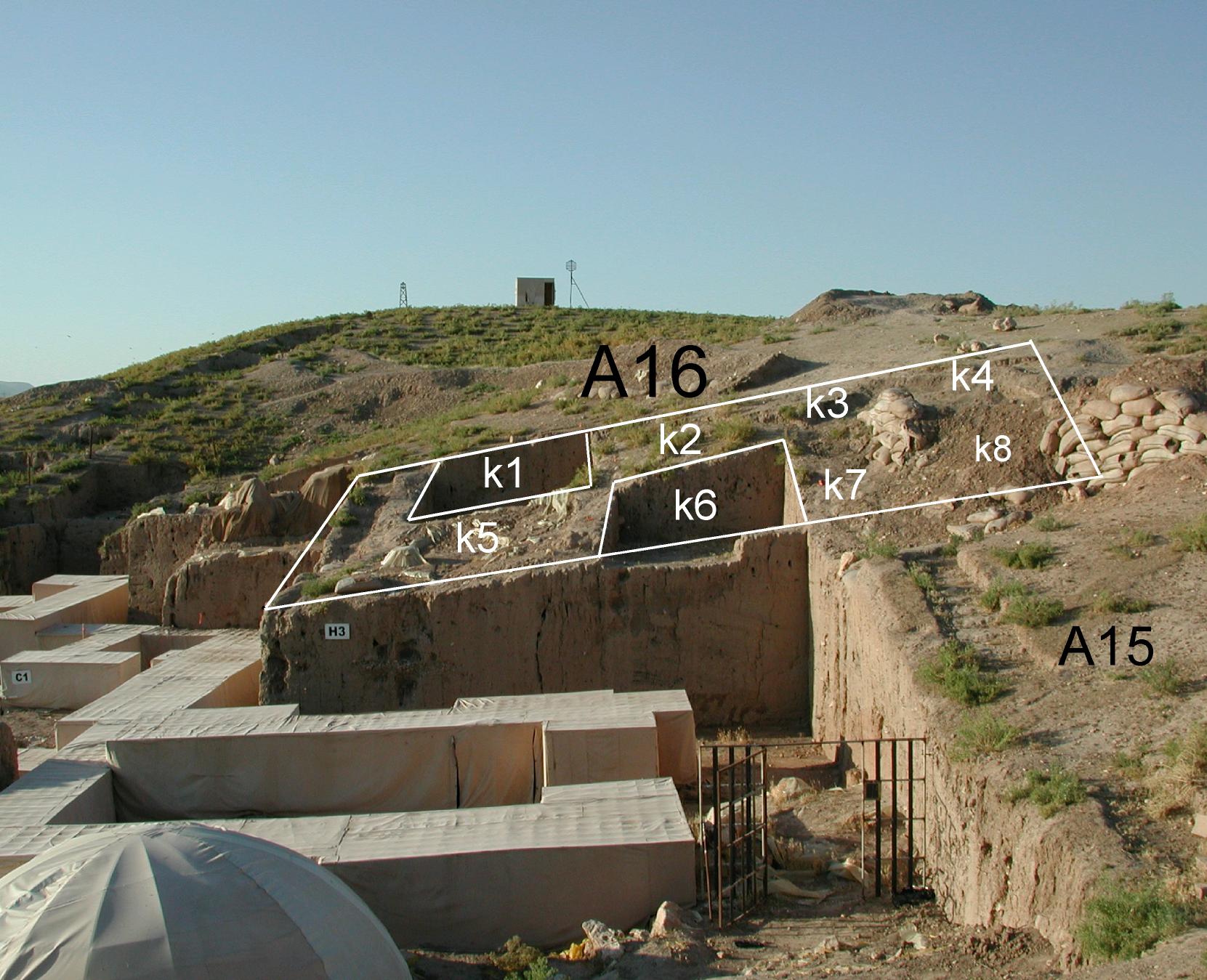
Back to top: Overview of Unit A16
End of excavations as of 2002
Excavations ended on September 24, 2002. The photo, taken on September 28, shows the situation as of that date.
The eight main squares defined at the beginning of the excavations have remained the same throughout both seasons.
In loci k1-2 and k5-6 we reached the level of the Palace floor, and exposed the stone pavement a12. In the other four loci to the east (k3-4 and k7-8), on the other hand, excavations stopped at the level of phase 5b, the Khabur period structures. In future years, we will have to complete the excavations of A16 by continuing the excavation of the eastern loci to the level of the Palace pavement. Because of our current strategy decision to aim for a full horizontal exposure of the later settlements before proceeding to the Palace levels, it will take several years before excavations in A16 may be completed.
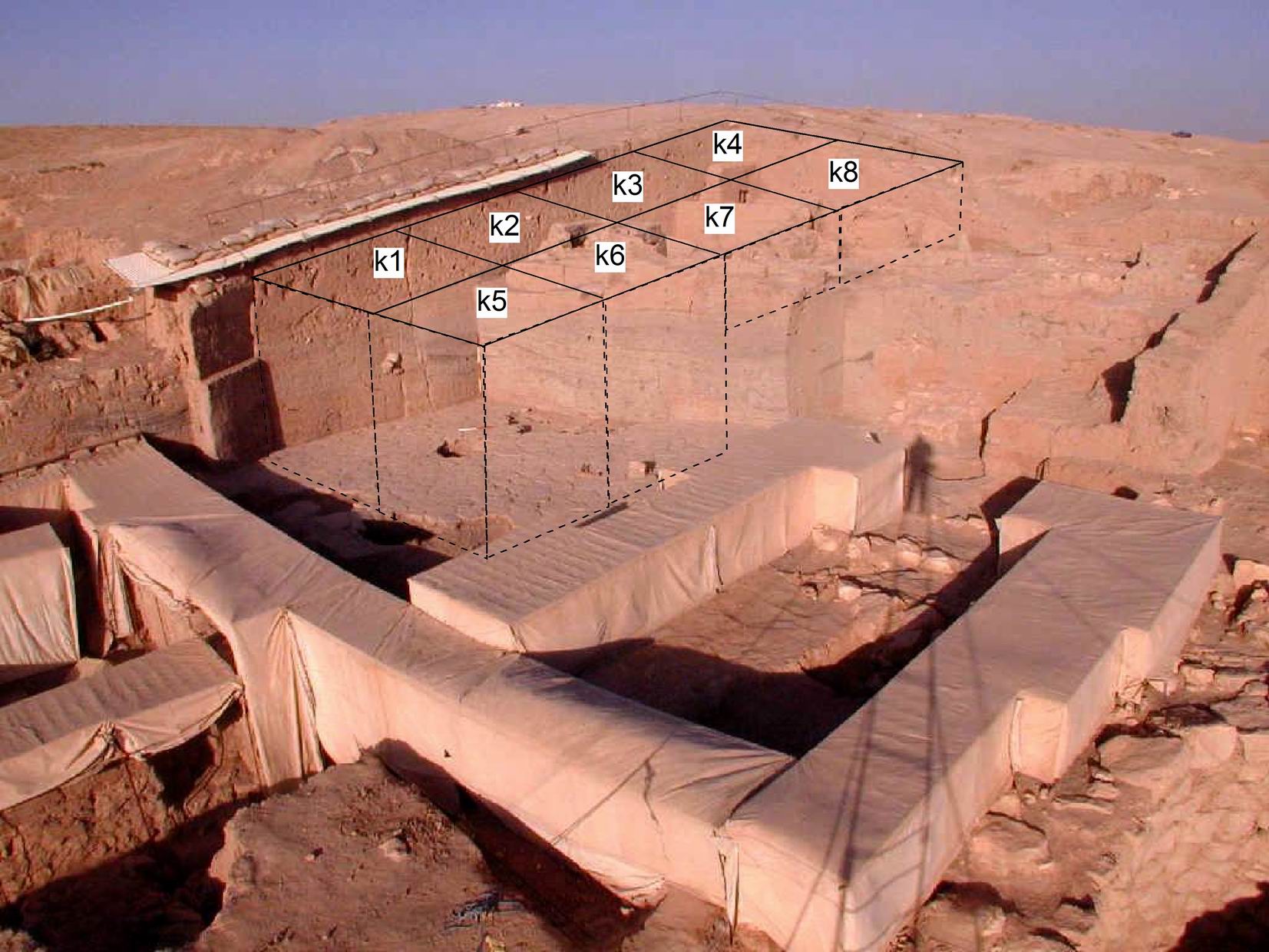
Back to top: Overview of Unit A16
Main results
The main results of the two seasons may be summarized as follows.
- The courtyard pavement of the Palace.
- Abandonment of the Palace.
- Heavy open area build-up following the abandonment.
- Long Khabur period sequence, including the burial complex.
- Large ceramic inventory and attendant statistics.
- Glyptic finds.
Back to top: Overview of Unit A16
General statistics
One will find here some of the major figures relating to the A16 books. More details will be found in the data set section.
| approximate cubic meters
|
350
|
| total number of features
|
347
|
| total number of items
|
1,138
|
| total number of q-lots
|
910
|
| total number of sherds
|
61,082
|
| total number of output files
|
21,459
|
| total number of records
|
4,464,649
|
| total number of hyperlinks
|
1,125,549
|
| total number of photographs
|
4,548
|
| total number of drawings
|
771
|
| total file size (with low resolution graphic files)
|
336 mB
|
Back to top: Overview of Unit A16